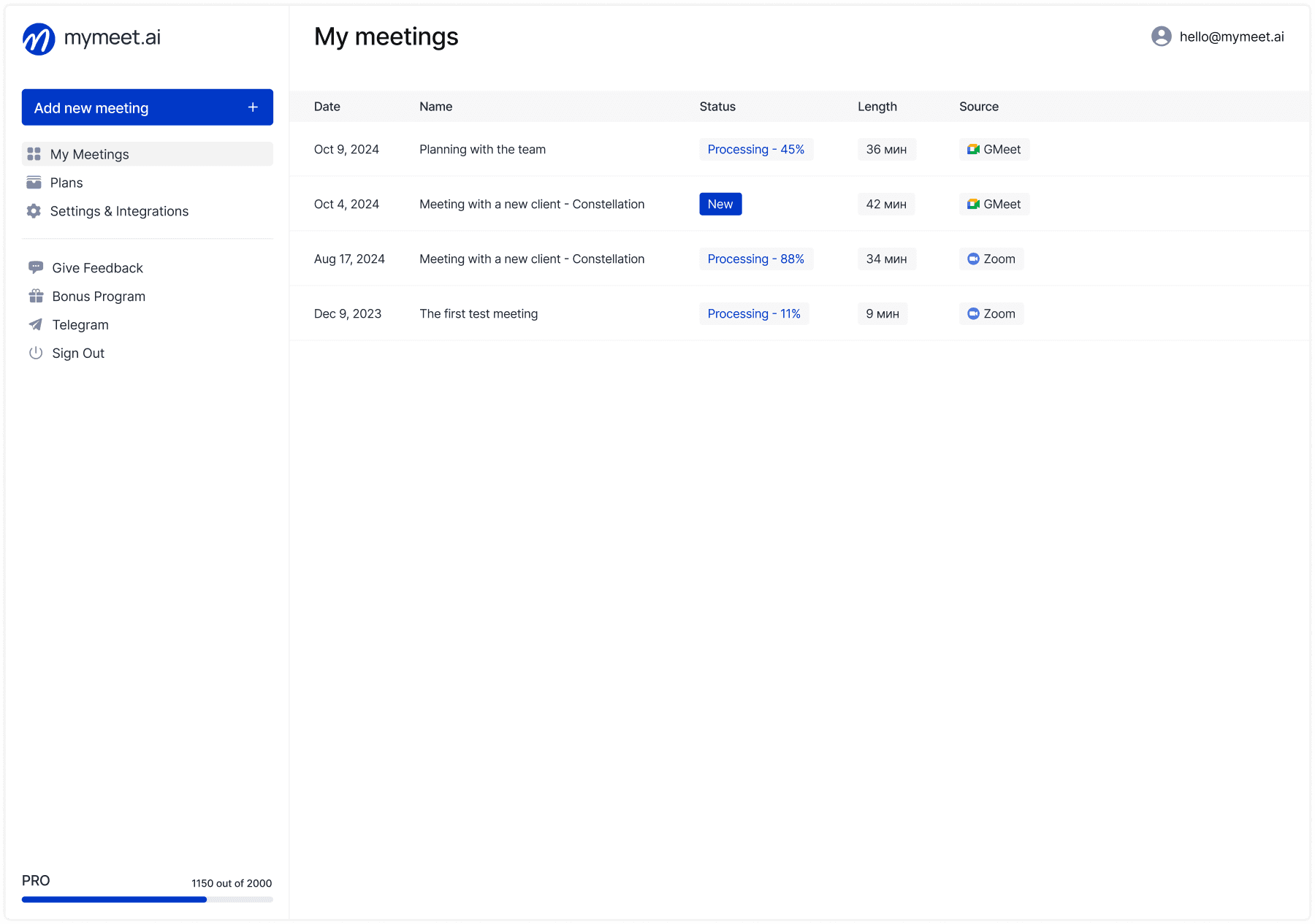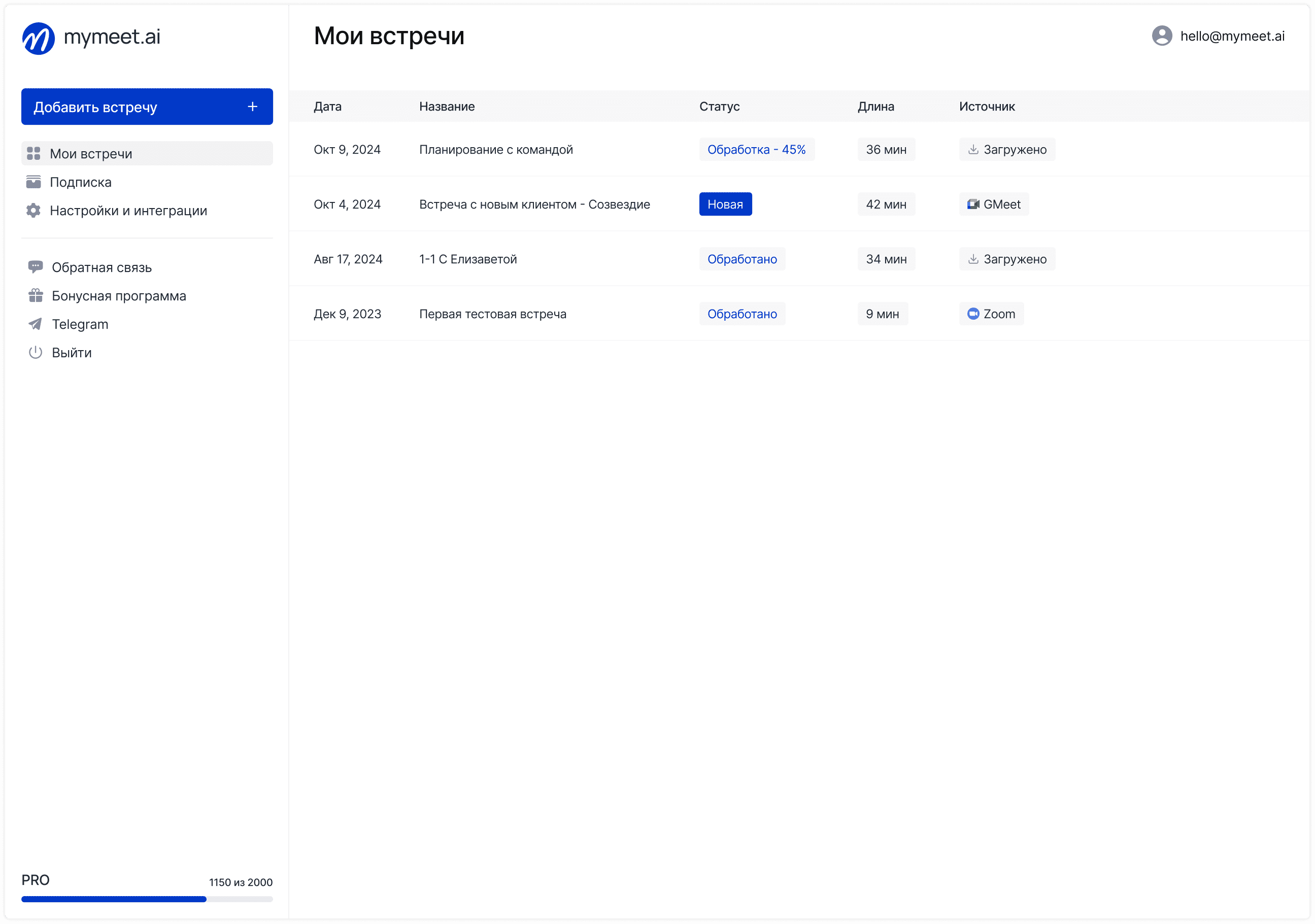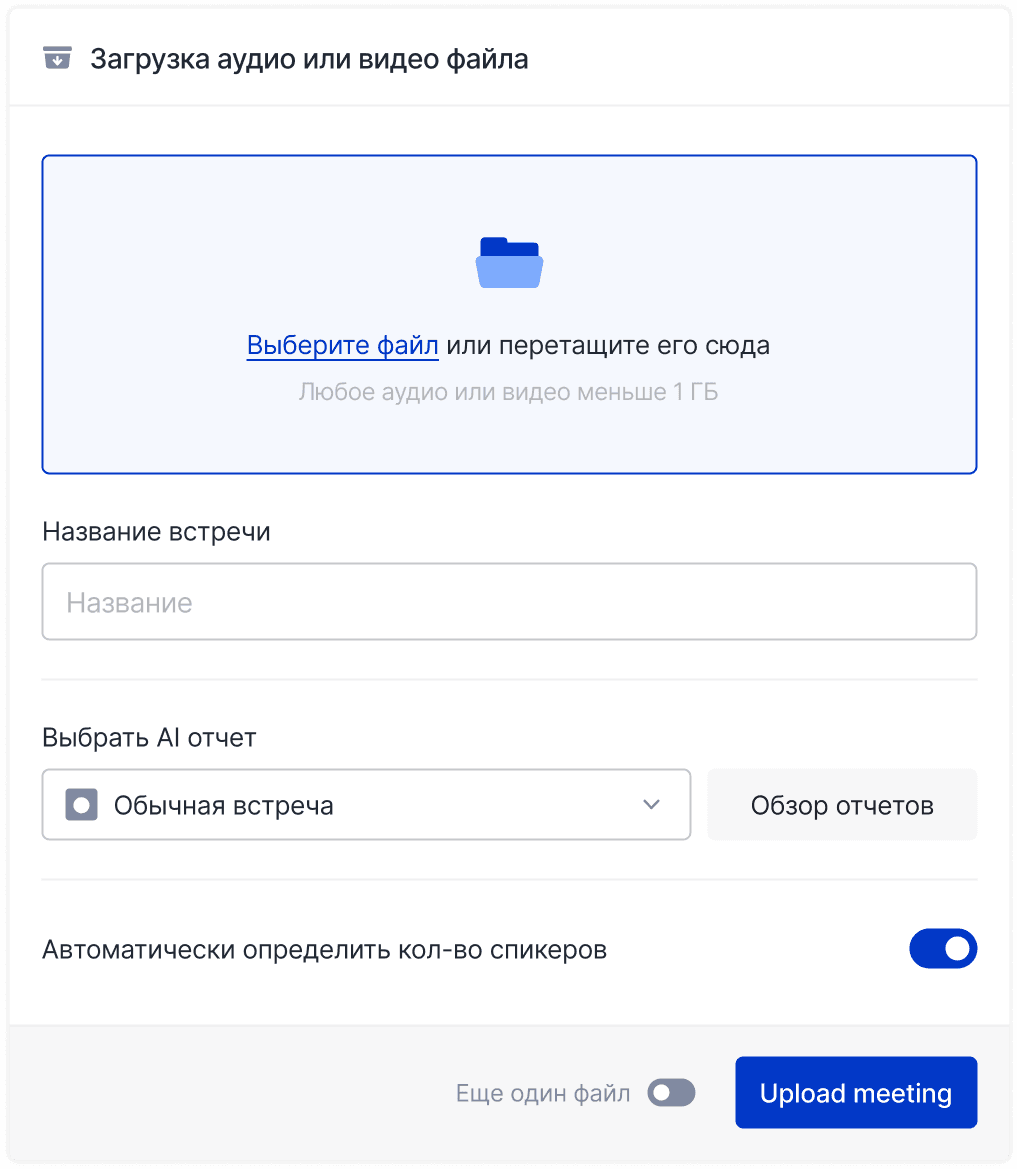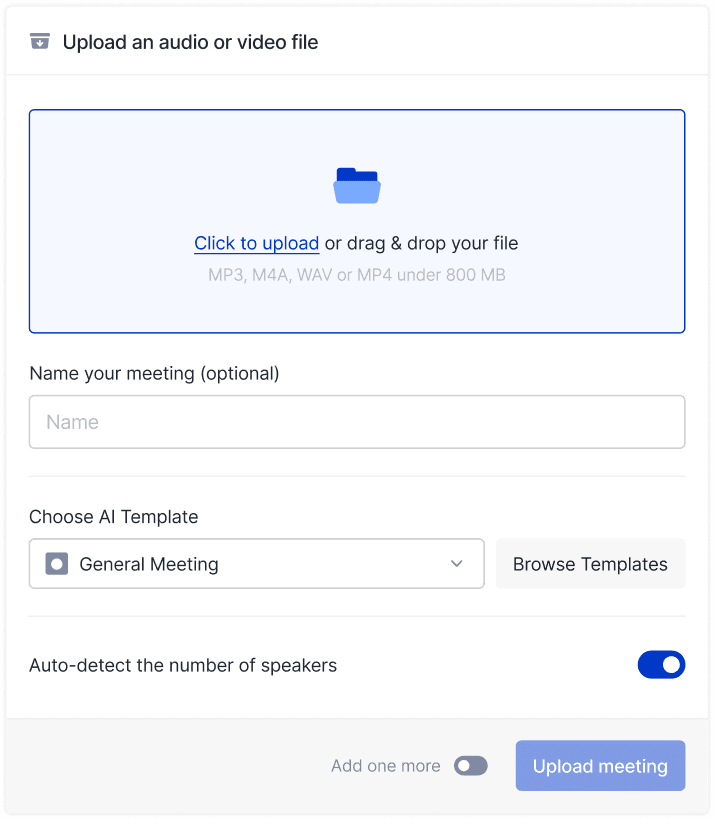Meeting Tips

Ilya Berdysh
Jul 4, 2025
A marketing agency director was spending 4 hours every week transcribing client interview recordings. The team conducted research, recorded conversations with respondents, but converting audio to text consumed enormous amounts of time. After implementing automatic transcription, these 4 hours were freed up for data analysis and insight preparation.
Transcription has become an integral part of modern work. Meetings, interviews, lectures, phone calls — wherever there's spoken word, text transcription may be needed. Technologies are evolving, and what used to take hours of manual work is now done automatically in minutes.
In this article, we'll explore what transcription is, what types and methods exist, how to apply transcription in different business areas, and how to choose the right solution for your tasks.
What is Transcription: Definition and Basics
Transcription is the process of converting spoken speech into written text. Simply put, it's the transcription of audio or video recordings into text format while preserving the meaning, structure, and speech characteristics of speakers.
Transcription differs from simple note-taking in that it conveys speech as accurately as possible, preserving pronunciation features, pauses, interjections, and emotional coloring. Unlike subtitles, transcription creates a full-fledged text document that can be edited, analyzed, and used in further work.
Basic Principles of Quality Transcription
Speech accuracy depends on adherence to key principles that determine the quality and practical value of the final text.
Verbatim Recording
Quality transcription conveys the speaker's speech as accurately as possible, including repetitions, slips of the tongue, and unfinished phrases. This is critically important for analyzing speech patterns, emotional state, and understanding discussion context. Verbatim recording preserves the authenticity of statements and prevents meaning distortion in subsequent result interpretation.
Speaker Separation
Transcription should clearly identify each speaker in dialogue. This is the foundation for analyzing negotiations, group discussions, and team meetings. Correct speaker separation simplifies discussion dynamics analysis and helps assess each participant's contribution to decision-making.
Timestamps
Text synchronization with time markers ensures quick navigation through recordings and the ability to instantly jump to key discussion moments. Timestamps are critically important for long meetings where you need to quickly find specific fragments or return to discussion of certain questions.
Preserving Speech Structure
Proper transcription conveys the logical organization of statements: paragraphs, enumerations, semantic accents, and significant pauses affecting context understanding. Structured recording significantly simplifies reading and analysis, increasing transcription's practical value for business tasks and decision-making.
Types of Transcription in Work: Classification and Features
Transcription has evolved from simple audio-to-text rewriting into an entire ecosystem of technologies. Each method solves specific business tasks with varying degrees of accuracy, speed, and cost. Choosing the right approach can save hundreds of work hours or ensure critically important accuracy.
The choice of transcription method determines result quality, processing speed, and process cost. One wrong decision can lead to redoing the entire project or losing important information.
Manual Transcription

The traditional method where a specialist listens to recordings and manually types text, ensuring maximum accuracy in conveying meaning, intonations, and context. A human understands context, can distinguish speakers by voice, correctly interprets complex terminology, and considers cultural speech features.
Manual transcription is indispensable for legal documents, medical reports, and scientific research where absolute accuracy is critically important. An experienced transcriber can work with low-quality recordings and correctly convey emotional coloring of statements.
Main disadvantages:
High time costs — transcribing one hour of audio takes 3-6 hours of work
Significant cost compared to automatic methods
Inability to scale for large content volumes
Human factor — possibility of errors when tired
Automatic AI Transcription

Machine learning algorithms analyze sound waves and turn them into readable text in minutes. Neural networks train on millions of hours of speech data, recognizing accents, speech tempo, and pronunciation features of different people.
Automatic systems process audio many times faster than humans — an hour-long recording becomes text in 5-10 minutes. AI can simultaneously process multiple files, automatically identify speakers, place punctuation, and create structured text with timestamps.
Key AI transcription capabilities:
Real-time audio processing
Recognition of multiple languages and accents
Automatic sentence and paragraph boundary detection
Integration with workflows and CRM systems
Automatic transcription quality depends on speech clarity, background noise level, and recognition algorithm sophistication. The method is optimal for processing large content volumes with speed requirements.
Hybrid Transcription

A combined approach that merges automatic recognition with subsequent manual checking and editing by humans. AI creates an initial transcription with high accuracy, after which a human editor checks and corrects the result.
The editor focuses on fixing recognition errors, clarifying terminology, and improving text structure without spending time typing from scratch. This approach reduces processing time by 2-3 times compared to fully manual transcription while maintaining high final text quality.
The hybrid method provides optimal balance between speed and accuracy, making it ideal for corporate meetings, interviews, and materials where combining speed and quality is important.
Types of Transcription by Content Type
Each type of audio material has its pitfalls and requires a special approach. Ignoring content specifics leads to poor-quality results that will need to be redone.
Meeting and Conference Transcription
Transcription of corporate meetings, client negotiations, and strategic sessions for recording decisions, task distribution, and communication effectiveness analysis. Features include multiple speakers, business terminology, need to highlight key decisions and action items. Requires content structuring by discussion topics and creating navigation elements.
Interview Transcription
Transcription of research interviews, journalistic materials, and HR interviews while preserving speech naturalness and accurate transmission of respondent opinions. Features include dialogue format, emotional component, need to preserve statement authenticity. May require delicate cleaning of filler words to improve readability without losing meaning.
Lecture and Webinar Transcription
Converting educational content to text format for creating notes, educational materials, and corporate knowledge bases. Features include monological structure, specialized terminology, logically organized material presentation. It's critically important to preserve presentation structure and highlight key theses for navigation.
Phone Call Transcription
Transcription of customer service calls, sales conversations, and technical support for analyzing service quality and process optimization. Features include limited audio quality, specific vocabulary, need for tonality and emotional dialogue coloring analysis. Often requires additional analytical processing to extract insights about interaction quality.
Criteria for Choosing Transcription Method
Choosing a transcription method is a decision of compromises between quality, time, and money. A calculation error can cost several times more than initial savings.
Main decision factors:
Result accuracy requirements
Project timeframes
Available budget
Source audio recording quality
Number of speakers
Terminology and context specifics
For critically important documents, manual transcription is recommended; for working materials, a hybrid approach works; and for mass processing — automatic transcription. Urgent tasks are better solved with automatic transcription, standard projects with hybrid methods, and quality processing without rush should be entrusted to manual transcription.
The right choice of transcription method ensures an optimal ratio of quality, speed, and cost for each specific task.
Business Applications of Transcription: Industry Solutions
Transcription has moved beyond simple audio-to-text rewriting and become a powerful business analytics tool. Companies use transcription to extract insights from negotiations, create content, and automate routine processes. Each industry has found unique ways to monetize this technology.
Transcription in Sales and Marketing
Sales departments have turned transcription into a competitive advantage. Analysis of transcribed calls reveals hidden success patterns and helps scale best practices across the entire team.
Transcription of manager calls reveals the anatomy of successful deals. Leaders identify which phrases lead to closing and which lead to rejections. Automatic transcription processing allows tracking sales script compliance and finding moments where deals "break."
Marketing teams turn one interview into dozens of materials. An hour-long expert conversation through transcription becomes an article, a series of LinkedIn posts, and an email campaign. Content managers save days of work using keyword search in transcriptions.
Focus group transcription turns hours of recordings into structured insights. Researchers quickly identify recurring problems and non-obvious customer needs through analysis of large volumes of qualitative data.
Transcription Applications in HR and Recruitment
HR specialists use transcription to reduce subjectivity in candidate assessment. Interview transcription helps make decisions based on facts, not intuition.
Candidate interview transcription removes human factors from the hiring process. HR managers compare different applicants' answers and analyze compliance with corporate values. Analysis platforms automatically highlight key competencies and red flags.
One-on-one meetings require precise documentation for tracking employee development. Transcription allows HR specialists to focus on dialogue while creating complete records of goal discussions and development plans.
Transcription in Education
Educational institutions use transcription to scale knowledge and create inclusive learning environments. Automatic lecture transcription saves teachers' time and improves learning quality.
Lecture transcription frees students from note-taking, allowing them to focus on understanding material. Students can search for needed information by keywords instead of reviewing hours of video recordings.
Transcription makes educational content accessible to people with hearing impairments, expanding program audiences. It also improves material absorption for all students when studying complex disciplines.
Transcription in Media and Journalism
Media companies use transcription to accelerate content production and increase publication accuracy. In competitive conditions, material preparation speed often determines publication success.
Journalists save hours of interview transcription work, getting the opportunity to publish news faster. Automatic transcription is especially valuable when working with press conferences where reaction speed is important.
Video content transcription automatically creates subtitles for YouTube and social networks, expanding audience reach. Text versions of videos improve SEO promotion and accelerate content production by 3-5 times.
Transcription in Legal Field
Law firms use transcription to document processes with highest accuracy requirements. In the legal sphere, transcription quality can affect case outcomes.
Accurate transcription of court hearings and depositions creates irrefutable documentary basis for case analysis. Lawyers can quickly find needed moments in multi-hour sessions through keyword search.
Quality documentation is critically important for procedural compliance and protecting client interests. Transcriptions serve as important evidence in legal proceedings.
mymeet.ai: Automatic Meeting Transcription for Business

Corporate meetings generate enormous amounts of important information that is often lost due to ineffective documentation. The mymeet.ai platform solves this problem through automatic transcription and AI content analysis.
Traditional Meeting Recording Problems
Most companies record meetings manually, creating critical problems for effective team work. Participants focus on note-taking instead of active discussion participation, losing important details and decision context.
A person physically cannot record everything said, so valuable ideas and agreements remain undocumented. Different participants interpret the same discussions differently, leading to discrepancies in understanding made decisions.
Manual records contain inaccuracies, omissions, and subjective interpretations, reducing their value for analysis. Lack of standardization complicates using records to improve processes and analyze trends.
How mymeet.ai Automatic Transcription Works
The platform uses advanced artificial intelligence technologies for automatic conversion of meeting participants' speech into structured text with intelligent content analysis.

The AI assistant automatically connects to meetings in Zoom, Google Meet, Microsoft Teams, and other video conferencing platforms without installing additional software. After meeting completion, the system creates detailed transcriptions with speaker separation and timestamps.
The system analyzes meeting content, highlighting key topics, making decisions, and assigned tasks. AI automatically structures information, creating brief summary, action items list with responsible parties and deadlines.
Key Platform Capabilities
Mymeet.ai offers a comprehensive solution for meeting documentation automation that goes far beyond simple transcription.
Main platform functions:
Real-time automatic transcription
High-quality language support and business terminology recognition
Speaker separation with automatic participant identification

Structured AI reports with key topic highlighting

Task and assignment extraction with responsible party assignment
AI chat for clarifying questions about meeting content

Specialized templates for different meeting types
CRM and task manager integration
These capabilities allow participants to fully focus on discussing strategic issues, entrusting documentation to artificial intelligence.
Client Results
Companies that implemented mymeet.ai achieve measurable results in time savings and meeting documentation quality improvement.
Electro.cars company reduced sales department meeting processing time by 15 hours per week. Managers stopped spending time on negotiation recording and focused on analyzing client needs and closing deals.
Digital agency BigDigital saves 50 hours per month on documenting client calls. Instead of creating protocols, the team receives ready structured reports with highlighted tasks and next steps.
Such results show the real value of automatic transcription for improving business communication efficiency and freeing team time for strategic tasks.
Want to integrate mymeet.ai into your corporate systems or get API access? Contact our sales team through the form.

How to Choose a Transcription Solution
Choosing a transcription platform determines whether you get a business growth tool or a headache with inaccurate results. The wrong decision will cost dozens of lost hours fixing errors and redoing work.
Service Selection Criteria
When choosing a platform, three factors are critically important for implementation success and investment return.
Key evaluation criteria:
Speech recognition accuracy — determines time spent editing results
Processing speed — affects team workflows
Functionality — determines platform value for business
Industry terminology and language support quality
Corporate system integration capabilities
Test systems on your real recordings — industry terminology, employee accents, and microphone quality strongly affect results. For operational decisions, live transcription is needed; for archive analysis, background processing works.
What to Consider When Automating
Implementing automatic transcription requires infrastructure preparation and team training. Skipping these steps leads to disappointment with technology.
Implementation preparation checklist:
☐ Evaluate current audio equipment quality
☐ Train team on recorded meeting rules
☐ Set up editing and result usage processes
☐ Integrate with existing work tools
☐ Test on real recordings before mass implementation
Source audio quality is the foundation of success. Poor recording will turn any platform into a nonsense generator. Invest in good microphones, conduct important meetings in quiet rooms, train participants to speak clearly.
Compliance and Security Considerations
Working with sensitive business data requires careful attention to data protection and regulatory compliance when choosing transcription solutions.
Language support quality varies significantly between platforms. Not all international solutions handle non-English languages effectively. Test systems thoroughly on materials with business vocabulary, technical terminology, and various speaking styles. Poor language recognition will turn transcription into unusable output.
Data protection requirements may limit platform choices for enterprise use. Solutions with local data processing or strong encryption are preferable for confidential information. Review privacy policies carefully and ensure your data isn't used for algorithm training without explicit consent.
Tips for Working with Transcription
Proper recording preparation and result processing turns raw technology into a powerful efficiency tool.
Quality recording rules:
Use external microphones instead of laptop built-ins
Check recording level before meeting start
Assign moderator for participant discipline control
Ask for introductions on first speech
Minimize background noise and interruptions
Effective process organization:
Create clear agenda with time frames
Announce transitions between discussion topics
Summarize made decisions at each block's end
Structure final transcription by topics
Highlight action items with responsible parties and deadlines
Technical preparation affects quality more than platform choice. Quality equipment pays for itself in the first week of use.
Properly configured transcription saves team work hours and turns chaotic discussions into structured action plans.
Conclusion
Transcription has evolved from a specialized service into a universal business efficiency tool. Modern AI technologies make speech-to-text conversion fast, accessible, and high-quality.
Automatic transcription helps companies save time, improve documentation quality, create valuable content, and analyze communication processes. From meetings and interviews to educational content — transcription application areas constantly expand.
Key advantages of modern transcription:
Employee time savings on routine documentation tasks
Increased accuracy of information recording and made decisions
Creating searchable knowledge bases from audio and video content
Improved information accessibility for all process participants
Choosing the right solution depends on your task specifics, but it's important to start using transcription capabilities now. Technologies develop quickly, and companies that implement them first gain competitive advantages.
Following simple recommendations for recording quality, process preparation, and result processing will help extract maximum benefit from modern transcription technologies.
Start small — try automatic transcription of your regular meetings with mymeet.ai. Free testing minutes will show how modern technologies can transform document flow and communication processes in your company.
FAQ on Transcription in Work
What is transcription and how does it differ from subtitles?
Transcription is a complete text transcription of audio or video that preserves all speech details. Subtitles are brief speech displays for video synchronization, often shortened for reading convenience.
What types of transcription work best for business?
For business, automatic and hybrid transcription are optimal. Automatic suits large content volumes, hybrid — when high accuracy is needed with limited time.
How long does automatic transcription take?
Modern AI systems process audio 5-10 times faster than real time. An hour-long recording becomes text in 6-12 minutes depending on material complexity.
How accurate is automatic transcription for clear speech?
Quality systems achieve high accuracy for clear speech in good recording conditions. Accuracy decreases with noise, accents, or specialized terminology.
What transcription methods are most economical?
Automatic transcription is the most economical method for large volumes. For critically important documents, hybrid approach is better: AI + human verification.
Is it safe to use cloud transcription services?
With proven providers having security certificates, risks are minimal. For confidential information, better choose solutions with local data placement.
Can transcription be used for content creation?
Yes, transcription is excellent for creating articles, posts, podcasts, and educational materials from interviews, lectures, and webinars. This accelerates content marketing many times over.
How to choose a platform for meeting transcription?
Pay attention to speech recognition accuracy, processing speed, additional analysis functions, and integration with your work tools.
What mistakes are most common when implementing transcription?
Main mistakes: poor recording quality, lack of team training, wrong expectations of AI accuracy, and ignoring need for result editing.
Is it worth investing in professional recording equipment?
For regular transcription use — yes. Quality microphones and recording conditions significantly improve results and reduce subsequent editing time.
Ilya Berdysh
Jul 4, 2025








